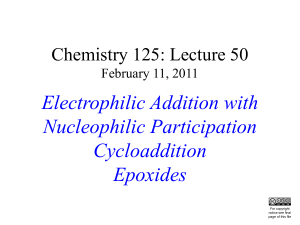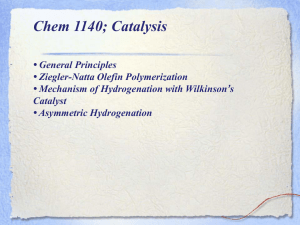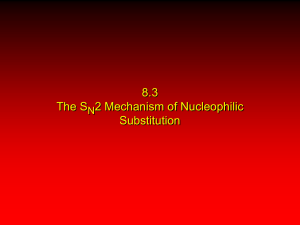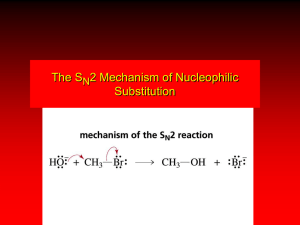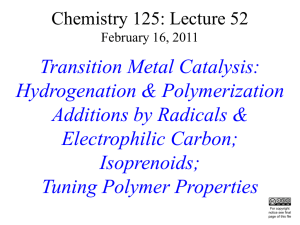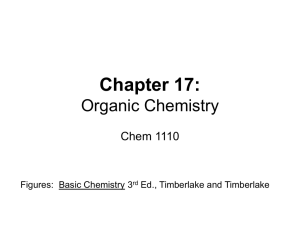Slide Show - LSU Macromolecular Studies Group
advertisement
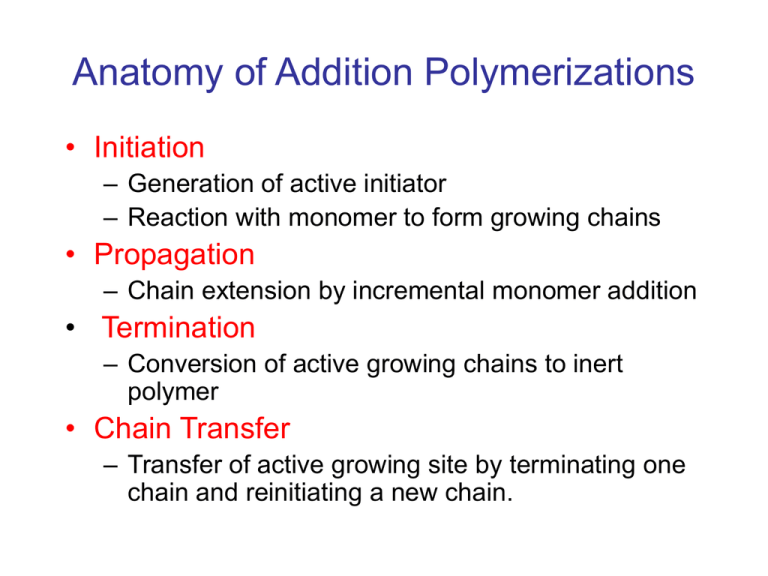
Anatomy of Addition Polymerizations • Initiation – Generation of active initiator – Reaction with monomer to form growing chains • Propagation – Chain extension by incremental monomer addition • Termination – Conversion of active growing chains to inert polymer • Chain Transfer – Transfer of active growing site by terminating one chain and reinitiating a new chain. Polymerizability of Vinyl Monomers Active Centers must be stable enough to persist though multiple monomer additions X radical cationic X • Typical vinyl monomers X anionic CN O O CH3 O R O OEt Polymerizability of Vinyl Monomers Monomers Radical Cationic Anionic Complex Metal Ethylene + + + Propylene +/+ 1,1-Dialkyl + olefins 1,2-Dialkyl olefins - + - + 1,3-Dienes + + + + + + + + Styrenes Polymerizability of Vinyl Monomers Monomers Radical Cationic Anionic Complex Metal VCl Vinyl esters Acylates/ methacrylat es Acrylonitrile s/ Acrylamides Vinyl ethers Substituted Styrenes + + + - + +/- + - + - + + +/- +/- +/- Types of Vinyl Polymerization Method Advantages Disadvantages Bulk (Neat) Simple equipment Rapid reaction Pure polymer isolated Heat buildup Gel effect Branched or crosslinked product Solution Good mixing Ready for application Lower mol. Wt. Low Rpoly Solvent Recovery Suspension (Pearl) Low viscosity Direct bead formation Removal of additives Emulsion High Rpoly Low Temperatures High Mol. Wt. High surface area latex Removal of additives Coagulation needed Latex stability Inverse Emulsion Water in oil latex formed Inversion promotes dissolution in water Commodity Vinyl Polymers Polystyrene (1920) PS Styrofoam, clear plastic cups envelop windows, toys Cl Poly(vinyl chloride) (1927) Cl Cl Cl PVC garden hose, pipe, car trim, seat covers, records, floor tiles Semi-Commodity Polymers CO2CH3 Poly(methyl methacrylate) (1931) CO2CH3CO2CH3 CO2CH3 CO2CH3 PMMA plexiglas, embedding resin, resist for X-ray applications F Polytetrafluoroethylene. (1943) teflon, non stick cookware, no grease bearings, pipe-seal tape F F F F F F F F F F F F F F F Suspension Polymerization Equivalent to a "mini-bulk" polymerization Advantages • • • • Aqueous (hydrocarbon) media provides good heat transfer Good particle size control through agitation and dispersion agents Control of porosity with proper additives and process conditions Product easy to recover and transfer Disadvantages • Suspending Agents contaminate product • Removal of residual monomer necessary Suspension (Pearl) Polymerization Process Type Aqueous Phase Monomers Used Product BEAD Polymer Soluble in Monomer 1% Sol. Polymer Suspending Agents Cu++ Inhibitors Styrene Methyl Methacrylate Vinyl Acetate Clear Beads POWDER Polmer Insoluble in Monomer Suspending Agents Electrolytes Vinyl Chloride Acrylonitrile Fluoroethylene Opaque Beads or Powders INVERSE Hydrocarbon Media Monomer Initiator Acrylamide Acrylic Acids Beads Emulsions Suspension Polymerization of Styrene Temp Monomer Phase 16.6 Kg. Styrene (0.5 kg Methacrylic Acid) 0.012 kg AIBN 0.006 kg Benzoyl Peroxide 0.015 kg tert-Butyl Perbenzoate Aqueous Phase: 16.6 Kg of H2O 0.24 kg Ca3PO4 0.14 kg Na+ Naphthalene sulfonate 0.077 kg. 15% Sodium Polyacrylate Polymerization Time. Hours EMULSION POLYMERIZATION • Advantages: • High rate of polymerization ~ kp[M] Npart/2 • High molecular weights, () of particles/ R. sec-1 = N kp [M] / Ri • • • • • Few side reactions High Conversion achieved Efficient heat transfer Low viscosity medium Polymer never in solution Low tendancy to agglomerate Emulsified polymer may be stabilized and used directly Disadvantages: Polymer surface contaminated by surface active agents Coagulation introduces salts; Poor electrical properties Components of Emulsion Polymerization Monomer Polymer Monomer Droplet 500-2000 A Monomer Micelle 20 -30 A R. Water soluble initiator Monomer Droplet 10,000 A (1 ) POLYMERS PRODUCED USING EMULSION PROCESSES Polymer Applications Styrene-Butadiene Rubber (SBR) Tires, Belting, Flooring, Molded goods, Shoe soles, Electrical insulation Butadiene-Acrylonitrile Fuel tanks, Gasoline hoses, Adhesives, Impregnated paper, leather and textiles (nitrile rubber) Acrylonitrile-ButadieneStyrene (ABS) Engineering plastics, household appliances, Automobile parts, Luggage Polyacrylates Water based latex paints Ziegler-Natta (Metal-Coordinated) Polymerization • • • • Stereochemical Control Polydisperse products Statistical Compositions and Sequences Limited set of useful monomers, i.e. olefins • SINGLE SITE CATALYSTS Polyolefins • Polypropylene (1954) • • • PP dishwasher safe plastic ware, carpet yarn, fibers and ropes, webbing, auto parts H IsotacticH X Tacticity H X X X X X All asymmetric carbons have same configuration • Methylene hydrogens are meso • Polymer forms helix to minimize substituent interaction Syndiotactic H • • • X X X X Asymmetric carbons have alternate configuration Methylene hydrogens are racemic Polymer stays in planar zig-zag conformation Heterotactic • X X (Atactic) Asymmetric carbons have statistical variation of configuration Ziegler’s Discovery • 1953 K. Ziegler, E. Holzkamp, H. Breil and H. Martin • Angew. Chemie 67, 426, 541 (1955); 76, 545 (1964). Al(Et)3 + NiCl2 CH3CH2CH=CH2 + Ni + AlCl(Et)2 100 atm 110 C + Ni(AcAc) + Cr(AcAc) + Zr(AcAc) Same result White Ppt. (Not reported by Holzkamp) White Ppt. (Eureka! reported by Breil) Al(Et)3 + TiCl4 CH2CH2 1 atm "linear" 20-70 C Mw = 10,000 - 2,000,000 Natta’s Discovery • 1954 Guilio Natta, P. Pino, P. Corradini, and F. Danusso • • J. Am. Chem. Soc. 77, 1708 (1955) Crystallographic Data on PP J. Polym. Sci. 16, 143 (1955) Polymerization described in French CH3 TiCl3 CH3 CH3 CH3 CH3 Al(Et)2Cl Isotactic CH3 VCl4 - 78 C Al(iBu)2Cl O in CH3 CH3 CH3 CH3 CH3 Syndiotactic Ziegler and Natta awarded Nobel Prize in 1963 Polypropylene (atactic) CH3 CH3 R * CH2 n Low molecular weight oils Formation of allyl radicals via chain transfer limits achievable molecular weights for all a-olefins Polypropylene (isotactic) CH3 TiCl3 CH3 CH3 CH3 Al(Et)2Cl Density ~ 0.9-0.91 g/cm3—very high strength to weight ratio Tm = 165-175C: Use temperature up to 120 C Copolymers with 2-5% ethylene—increases clarity and toughness of films Applications: dishwasher safe plastic ware, carpet yarn, fibers and ropes, webbing, auto parts CH3 Polyethylene (HDPE) CH3 Essentially linear structure Few long chain branches, 0.5-3 methyl groups/ 1000 C atoms Molecular Weights: 50,000-250,000 for molding compounds 250,000-1,500,000 for pipe compounds >1,500,000 super abrasion resistance—medical implants MWD = 3-20 density = 0.94-0.96 g/cm3 Tm ~ 133-138 C, X’linity ~ 80% Generally opaque Applications: Bottles, drums, pipe, conduit, sheet, film Polyethylene (LLDPE) • Copolymer of ethylene with a-olefin CH3 CH3 CH3 CH3 CH3 x y Density controlled by co-monomer concentration; 1-butene (ethyl), or 1-hexene (butyl), or 1-octene (hexyl) (branch structure) Applications: Shirt bags, high strength films CATALYST PREPARATION Ball mill MgCl2 (support) with TiCl4 to produce maximum surface area and incorporate Ti atoms in MgCl2 crystals Add Al(Et)3 along with Lewis base like ethyl benzoate Al(Et)3 reduces TiCl4 to form active complex Ethyl Benzoate modifies active sites to enhance stereoselectivity Catalyst activity 50-2000 kg polypropylene/g Ti with isospecificity of > 90% Catalyst Formation AlEt3 + TiCl4 → EtTiCl3 + Et2AlCl Et2AlCl + TiCl4 → EtTiCl3 + EtAlCl2 EtTiCl3 + AlEt3 → Et2TiCl2 + EtAlCl2 EtTiCl3 → TiCl3 + Et. (source of radical products) Et. + TiCl4 → EtCl + TiCl3 TiCl3 + AlEt3 → EtTiCl2 + Et2AlCl UNIPOL Process N. F. Brockman and J. B. Rogan, Ind. Eng. Chem. Prod. Res. Dev. 24, 278 (1985) Temp ~ 70-105°C, Pressure ~ 2-3 MPa General Composition of Catalyst System Group I – III Metals AlEt3 Et2AlCl EtAlCl2 i-Bu3Al Et2Mg Et2Zn Et4Pb Transition Metals Additives TiCl4 a,g, d TiCl3 MgCl2 Support VCl3, VoCL3, V(AcAc)3 Titanocene dichloride Ti(OiBu)4 H2 O2, H2O (Mo, Cr, Zr, W, Mn, Ni) HMPA, DMF R C CH R-OH Phenols R3N, R2O, R3P Aryl esters Adjuvants used to control Stereochemistry O O Si CH2CH3 O O O N H Ethyl benzoate 2,2,6,6-tetramethylpiperidine Hindered amine (also antioxidant) Phenyl trimethoxy silane Nature of Active Sites R R Al R Cl Cl Ti Cl Cl Monometallic site H3C d CH2 Cl d Ti Cl Cl Al R R Bimetallic site Active sites at the surface of a TiClx crystal on catalyst surface. Monometallic Mechanism for Propagation Monomer forms π -complex with vacant d-orbital CH2 Cl Ti Cl Cl Cl CH3 CH2 Cl Ti Cl Cl Cl CH3 Alkyl chain end migrates to π -complex to form new σ-bond to metal H2C CH3 Cl Ti Cl Cl Cl CH2 CH2 Cl Ti Cl Cl Cl CH3 Monometallic Mechanism for Propagation Chain must migrate to original site to assure formation of isotactic structure H2C CH3 Cl Ti Cl Cl Cl CH2 H3C CH2 Cl Ti Cl Cl Cl If no migration occurs, syndiotactic placements will form. Enantiomorphic Site Control Model for Isospecific Polymerization Stereocontrol is imposed by initiator active site alone with no influence from the propagating chain end, i.e. no penultimate effect Demonstrated by: 13C analysis of isotactic structures not Stereochemistry can be controlled by catalyst enantiomers Modes of Termination 1. β-hydride shift C H CH2 Ti CH2 CH2 H Al R Ti Al CH2 Ti R Al R 2. Reaction with H2 (Molecular weight control!) C H H H CH2 Al Ti R CH2 CH3 H Ti Al R CH2 Ti R Al Types Of Monomers Accessible for ZN Processes 1. a-Olefins H2C CH2 CH2CH3 CH3 R 2. Dienes, (Butadiene, Isoprene, CH2=C=CH2) trans-1,4 cis-1,4 iso- and syndio-1,2 1.2 Disubstituted double bonds do not polymerize Ethylene-Propylene Diene Rubber (EPDM) S. Cesca, Macromolecular Reviews, 10, 1-231 (1975) + + CH3 Catalyst soluble in hydrocarbons VOCl3 Et AlCl V(AcAc)3 2 .4-.8 .5-.1 0.05 Continuous catalyst addition required to maintain activity Rigid control of monomer feed ratio required to assure incorporation of propylene and diene monomers Development of Single Site Catalysts R Cl Cl Ti Cl Cl Z-N multisited catalyst, multiple site reactivities depending upon specific electronic and steric environments Me Single site catalyst— every site has same chemical environment Kaminsky Catalyst System W. Kaminsky et.al. Angew. Chem. Eng. Ed. 19, 390, (1980); Angew. Chem. 97, 507 (1985) Me X + X CH3 * Al O * n Al:Zr = 1000 Linear HD PE Activity = 107 g/mol Zr Me = Tl, Zr, Hf CH3 Atactic polypropylene, Mw/Mn = 1.5-2.5 Activity = 106 g/mol Zr Methylalumoxane: the Key Cocatalyst CH3 toluene Al(CH3)3 + H2O 0C Al O O O O Al Al O O Al Al Al Al O * n n = 10-20 CH3 Al * CH3 CH3 MAO Proposed structure Nature of active catalyst CH3 X Cp2Me + * X Al O * n MAO Cp2Me CH3 CH3 + Al O X CH3 Cp2Me CH2 + Transition metal alkylation X Al m O X X Al O Al O m Ionization to form active sites Noncoordinating Anion, NCA Homogeneous Z-N Polymerization Advantages: High Catalytic Activity Impressive control of stereochemistry Well defined catalyst precursors Design of Polymer microstructures, including chiral polymers Disadvantages: Requires large excess of Aluminoxane (counter-ion) Higher tendency for chain termination: β-H elimination, etc. Limited control of molecular weight distribution Evolution of single site catalysts Date Metallocene 1950’s Stereo control Performance None Moderate Mw PE Some comonomer incorporation Me Early 1980’s None Me High MW PE Better comonomer incorporation Synthesis of Syndiotactic Polystyrene N. Ishihara et.al. Macromolecules 21, 3356 (1988); 19, 2462 (1986) Ti * Al O CH3 + n* Cl Styrene Cl 44.1% Ti Cl Cl Cl Ti 99.2% syndiotactic polystyrene Cl Cl 1.0% m.p. = 265C Evolution of single site catalysts Date Metallocene Late 1980’s N Stereo control Slight Performance Very High Mw PE, excellent comonomer incorporation Highly Syndiotactic Used commercially for PP Me R Late 1980’s R R Me Early 1990’s Highly Used commercially Isotactic for PP Me Technology S-curves for polyolefin production


